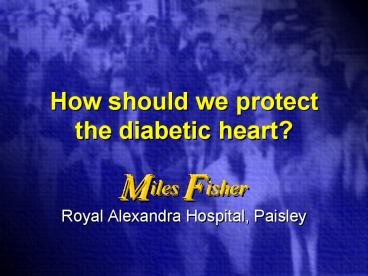How should we protect the diabetic heart - PowerPoint PPT Presentation
1 / 29
Title:
How should we protect the diabetic heart
Description:
Diabetes mellitus is a state of chronic hyperglycaemia which may result from ... How to avoid polypharmacy/encourage compliance (OHAs, statin, ACEI, aspirin, etc) ... – PowerPoint PPT presentation
Number of Views:81
Avg rating:3.0/5.0
Title: How should we protect the diabetic heart
1
How should we protect the diabetic heart?
- Miles Fisher
- Royal Alexandra Hospital, Paisley
2
WHO Definition of Diabetes Mellitus
- Diabetes mellitus is a state of chronic
hyperglycaemia which may result from many
environmental and genetic factors, often acting
jointlyWHO Expert Committee on Diabetes
Mellitus 1980
3
Re-definition of Diabetes
- Diabetes is a state of premature cardiovascular
death which is associated with chronic
hyperglycaemia and may also be associated with
blindness and renal failureMiles Fisher,
Dublin 1996
4
Haffner - Results
incidence
Haffner et al. N Engl J Med 1998 339 229-34
5
Diabetes and heart abnormalities
- Coronary heart disease
- Specific heart disease of diabetes
- Diabetic autonomic neuropathy
6
Coronary heart disease and diabetes
- Studied using
- epidemiology
- post-mortem
- electrocardiography
- angiography
- Coronary heart disease more prevalent, more
extensive, more diffuse - High prevalence of silent ischaemia
7
Myocardial infarction
- Mortality twice the non-diabetic
- Increased silent or painless infarction
- Delay in receiving treatment
- Increased congestive cardiac failure, cardiogenic
shock, rupture, re-infarction
8
How should we protect the diabetic heart?
- Treat the diabetes (primary prevention)
- Treat the cardiovascular risk factors
- Other preventative measures
- Treat the heart disease
- Miles Fisher Dublin 1996
9
Management of diabetic cardiovascular disease
SIGN Guideline 19
- Primary prevention and risk factor management
- Treatment of acute myocardial infarction and
secondary prevention - Implementation of the guideline
- Review of the guideline and recommendations for
research - August 1997
10
Treatment of Type 1 Diabetes and Heart Disease -
DCCT
- Reduction by 41 in risk of all major
cardiovascular and peripheral vascular events
combined - Mortality not significantly different between the
treatment groups
11
Treatment of Type 2 Diabetes and Heart Disease -
UKPDS
- Significant reduction in retinopathy,
microvascular end-points and diabetes related
end-points - Non-significant reduction by 16 in risk of
myocardial infarction (p0.052) - Mortality not significantly different between the
treatment groups
12
How should we protect the diabetic heart?
- Treat the diabetes (primary prevention)
- Treat the cardiovascular risk factors
- Other preventative measures
- Treat the heart disease
13
Cardiovascular Risk Factors and Diabetes
- Data from epidemiological studies including
Framingham - Usual risk factors apply - smoking, obesity,
hypertension, hyperlipidaemia, fibrinogen - Unique role for diabetes as an independent
factor - Evidence supporting response to risk factor
reduction in diabetes now available for
hypertension and hyperlipidaemia
14
HBP Studies in Diabetes
- Completed
- ABCD
- FACET
- HDS
- HOT
- SHEP
- Syst-Eur
- Ongoing
- ALLHAT
- Multiple ongoing studies including large numbers
of patients with diabetes
15
Hypertension and Diabetes
- Of proven benefit
- ACEI
- B-blockers
- Diuretics
- Calcium channel blockers (felodipine,
nitrendipine)
- Caution required
- Amlodipine
- Doxazosin
- Isradipine
- Nisoldipine
16
Lipid Studies in Diabetes
- Completed
- 4S
- CARE
- LIPID
- VA-HIT
- DAIS
- Ongoing
- ALLHAT
- CARDS
- FIELD
- LDS
- etc
17
How should we protect the diabetic heart?
- Treat the diabetes
- Treat the cardiovascular risk factors
- Other preventative measures (primary
prevention) - Treat the heart disease
18
Other Preventative Measures
- Proven
- Aspirin
- Ramipril (HOPE)
- Uncertain
- Weight loss
- Exercise
- HRT
19
Aim of the HOPE Study
- To evaluate the efficacy of the ACE inhibitor
ramipril and the anti-oxidant vitamin E in
reducing the incidence of MI, stroke, or CVD
death in people considered to be at high risk of
CVD
HOPE Study Investigators. Can J Cardiol, 1996
20
Inclusion Criteria 1
- Patients ?55 years of age
- Previous myocardial infarction, PTCA or CABG
- Stable or unstable angina
- Peripheral vascular disease
- Stroke
HOPE Study Investigators. Can J Cardiol, 1996
21
Inclusion Criteria 2
- Diabetes combined with
- BP gt160mmHg, diastolicgt90mmHg, or on treatment
- Total cholesterol gt5.2mmol/L or HDL lt0.9mmol/L
- Smoking
- Microalbuminuria
- Any evidence of previous vascular disease
HOPE Study Investigators. Can J Cardiol, 1996
22
Primary Endpoint
- All CVD events
- Defined as a combined endpoint of
- CVD death or
- MI or
- Stroke
HOPE Study Investigators. Can J Cardiol, 1996
23
Effect of Ramipril on CV Events in Patients With
Diabetes
24
Survival Curves on Primary Outcome - DM
25
How should we protect the diabetic heart?
- Treat the diabetes
- Treat the cardiovascular risk factors
- Other preventative measures (primary
prevention) - Treat the heart disease
26
CHD and diabetes
- Proven
- Aspirin
- Beta blockade
- ACE inhibition (CCF)
- CABG
- Uncertain
- Other anti-anginal therapy
- ACE receptor antagonists
- Other treatments for CCF
- PTCA?
- Heart transplantation?
27
MI and diabetes
- Proven/Certain
- Aspirin
- Thrombolysis
- Beta blockade
- ACE inhibition
- Uncertain/
- Controversial
- Intravenous insulin / subcutaneous insulin
- Primary angioplasty
28
Unanswered questions?
- Should we be screening all patients for CHD?
- How to implement guidelines?
- How to avoid polypharmacy/encourage compliance
(OHAs, statin, ACEI, aspirin, etc)? - What is the role of intravenous insulin following
myocardial infarction?
29
Conclusions
- Evidence-based medicine provides information on
protecting the diabetic heart - Further studies will expand the evidence base
- Evidence-based guidelines are available
- Implementation is the big challenge































